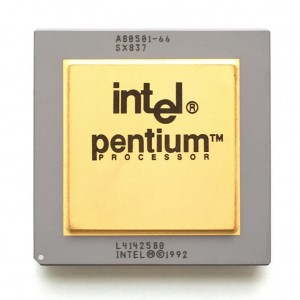- Posted March 22, 2014, 1:53 p.m. - 10 years, 1 month ago
Intel Pentium Processors
March 22nd marked the anniversary of Intel’s release of fifth generation microarchitecture with the Pentium processors making their first appearance in 1993. X86 compatible, the Pentiums superseded Intel’s 486 technology and became a global brand which has extended over 2 decades.
Originally known as the i586, Intel were unable to trademark this product name and therefore through Lexicon Branding, the American marketing company whose name creations include the PowerBook for Apple and Blackberry, the Pentium name was born. Intel trademarked the name Pentium, and such was the success that in later years Intel’s CEO confirmed that Pentium was indeed a more recognised brand than Intel itself.
Having been working on the design since 1989, with the launch of Pentium came the first generation of chips to over superscalar architecture, allowing for faster throughput through dual pipelines, and with 3.1million transistors the 60-66 MHz chip also included an improved faster floating point unit (FPU). This latter feature would result in a difficult time for Intel following the discovery of what was named the FDIV bug, with the company having to offer replacement chips to all customers even though the problem itself was only ever experience by a select few as it involved occasional generation of incorrect results when completing complex math calculation.
The Pentium range grew to include the Pentium Pro launched in 1995 which provided Intel’s P6 microarchitecture, and the Pentium MMX which allowed for improved performance on multimedia tasks with the addition of 57 MMX instructions. With the growth in the mobile market, Intel launched the Pentium II the following year, with the Pentium III then appearing in February 1999.
Intel offered higher clock frequencies with the Pentium 4 in 2000 which featured NetBurst microarchitecture for the first time, and in 2003 introduced the Pentium M again offering greater power efficiency. 2006 marked the first appearance of Pentium Dual-Core technology and a change in Intel’s naming process, from then on Intel’s Core microarchitecture would feature with the release of its’ Intel Core 2 Duo Processors followed by the 2nd and 3rd generation releases in 2010 and 2012.
The Pentium name continues to remain in use by Intel and can be found it is releases of new microarchitecture including Sandy Bridge, Nehalem and Ivy Bridge.
Image Credit: http://bit.ly/1gx6tgo
Latest Articles
-
Our latest testimonial for Infix 6
Dec. 19, 2016, 2:40 p.m. -
Most commonly translated Turkish words
Feb. 6, 2015, 9 a.m. -
Merry Christmas & A Happy New Year
Dec. 25, 2016, 8 a.m. -
New Save PDF to SVG feature introduced to Spire.Office
Dec. 23, 2016, 11:54 a.m. -
Editing educational PDFs – a user perspective
July 21, 2014, 8:03 a.m.



